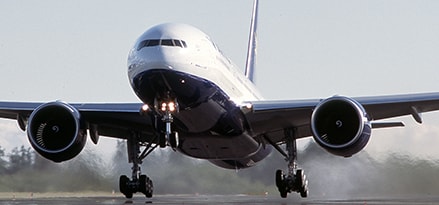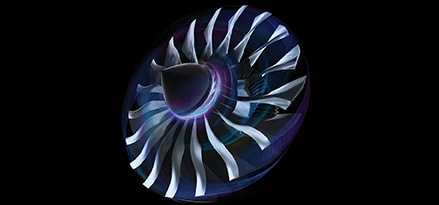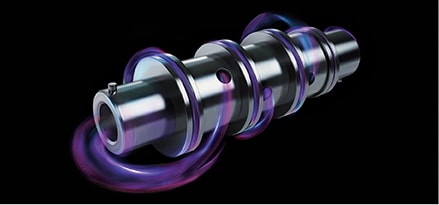General questions
Here is a brief list of common industry terminology:
|
APU |
Auxiliary Power Unit |
|
CSD |
Constant Speed Drive |
|
IDG |
Integrated Drive Generator |
|
BPR |
Bypass Ratio |
|
TBO |
Time Between Overhaul |
|
MTBF |
Mean Time Between Failures |
|
MTBR |
Mean Time Between Removals |
|
SFC |
Specific Fuel Consumption |
|
EGT |
Exhaust Gas Temperature |
|
ETOPS |
Extended Twin-engine Operations |
|
IFSD |
In-flight Shutdown |
Dates defined:
− Date Printed represents the date the certificate of oil analysis was printed
− Plant Dispatch Date represents the fill date; this is the date the product was actually packaged/filled in its container
− Date of Manufacture represents the certification date, or testing date
Jet turbine oils
Many airlines prefer quart cans. Quart cans provide for ease in handling when performing reservoir "top-offs" during maintenance checks. Additionally, quart cans have a longer shelf life as a result of hermetic sealing. Jet oils are extremely hygroscopic due to their chemical composition; they can attract/pick up moisture from the air easily, even past the bungholes on pails and drums, due to expansion and contraction associated with temperature swings. Once a quart can is opened it is difficult to reseal, and as such, should be used entirely or disposed of. Reusing open quart cans increases risk associated with collection of moisture and/or other potential contaminants (e.g., dust, dirt, etc.), therefore it is recommended for single use application only.
The shelf life for all Mobil Jet oils in metal quarts is 10 years, and five years for all products in pails or drums. We recommend effective inventory management be employed to ensure the stock of Mobil Jet oils is rotated for storage and use.
With regard to handling, please refer to the Material Safety Data Sheet (MSDS). Generally no special precautions are necessary beyond standard good hygiene practices. In addition, there is no need to shake, stir or otherwise agitate the oil before use. The ester base oils used in Mobil Jet™ Oil II and Mobil Jet™ Oil 254 gas turbine lubricants have excellent additive compatibility and long-term storage stability characteristics.
A certificate of compliance is a document similar to what's commonly referred to as a Certificate of Analysis (COA). COAs are filed for every batch of Mobil Jet oil produced. A COA can be obtained by contacting your ExxonMobil source point or downloading a copy from our website.
Gas turbine oil coloring is determined by the additive package selected and can vary between oils. It is not an indicator of oil quality or suitability.
Yes, they are compatible. The oil approval process includes compatibility testing for all jet oils. Approval requirements mandate that jet oils must have full capability in any proportion with any other similarly certified oil. The US Military also requires that qualified oils be compatible with other oils that meet the same specification.
First, always consult with the engine/equipment builder recommendations prior to enacting the changeover to ensure compliance. Next, we recommend converting systems by simply "topping-off" the system with the new oil. This approach allows the original brand of oil to be phased out gradually over time as more "top-offs" occur. The standard "drain and fill" method is less desirable because there is the potential for disturbing system equilibrium (e.g., seal swell/compatibility, deposit loosening/washing, etc). Since oil is consumed in a jet engine on a regular basis (average - 0.20-0.80 quarts/hr), estimates indicate the oil system will typically contain more than 95 percent of the new oil in a few hundred hours of operation.
The biggest difference is that land based installations do not have the benefit of ram air cooling and therefore the reservoirs typically are larger (500+ gallons versus 6 gallons) in order to provide sufficient residence time for oil cooling. Additionally, many land-based turbines are run intermittently for peak electrical or gas compression periods, as opposed to every day as in the case of aircraft engines. All of this results in the potential for a higher possibility of acid formation due to buildup of moisture/water in the lubricant. As such, many equipment manufactures recommend reservoir drain and flush service intervals to ensure continued oil performance. It should be noted that while the larger reservoir systems provide for oil cooling, the internal engine temperatures are every bit as severe as those seen in an aircraft engine. Therefore the need for good thermal stability is still a critical performance feature of synthetic jet turbine lubricants used in land-based applications.
Mobil Jet oils are compatible with the materials provided under normal conditions of jet engine operation. For compounds and components (e.g., plastics) not typically used in aviation engines, compatibility studies must be run. Even with elastomers, great care must be exercised when applying data from one study to another. Unique circumstances could result in a response that is different from that predicted in a study. Elastomers, like lubricants, have many and varied formulations, all of which may not react in a similar fashion under the same conditions. Consequently, each situation/application must be evaluated separately.
Mobil Jet oils have a safe history of use in both ground and air operations for more than 50 years. ExxonMobil is not aware of any adverse long-term health effects associated with aircraft use of jet engine oils. Refer to the MSDS (Material Safety Data Sheets) for additional handling and safety information.
Hydraulic fluids
Mobil HyJet IV-Aplus and Mobil HyJet V are fire-resistant hydraulic oils while other 5606 fluids are not considered fire-resistant. Fire-resistant fluids have evolved over time as commercial jet travel has become more prevalent. Fire-resistant fluids were developed to accommodate increased aircraft speeds during landing and withstand higher braking temperatures. Fire resistance properties of these oils include high auto-ignition temperature and zero flame propagation. Additionally, the oils must meet special OEM test requirements such as hot manifold ignition and high- and low-pressure spray tests, among others.
Fire-resistant hydraulic oils are dyed purple to differentiate them from 5606 fluids, which are red in color.
In addition to normal housekeeping requirements used to minimize contamination, you should also minimize any periods of exposure of the product to air by keeping containers closed for storage. Mobil HyJet products will rapidly absorb moisture from the air, which will lead to hydrolysis – a chemical degradation of the product. Previously opened containers with low fluid content should therefore not be stored for long periods of time.
Long-term exposure to Mobil HyJet products can cause irritation and dry skin. These fluids will also be painful if they come in contact with the eye, although there is no evidence of long-term harm to the eye. Accordingly, proper personal protective equipment should be used when handling HyJet products.
Proper handling of Mobil HyJet products is well documented in the MSDSThe shelf life of Mobil HyJet IV-Aplus and Mobil HyJet V hydraulic fluids is 10 years for quarts and gallons, and five years in pails and drums. The date of manufacture can be determined using the batch and fill codes printed on each package.
Mobil HyJet products are fully compatible in any proportion with each other and with other commercially available phosphate ester based hydraulic fluids. Additionally, aircraft OEM require a multitude of compatibility tests, including compatibility tests with metals, elastomers, solvents and paints. Please contact your ExxonMobil aviation representative for specific compatibility inquiries.
Conversion is typically completed using the “top-off” method in which Mobil HyJet products are added to hydraulic reservoirs as required to maintain proper fluid levels. Using this method, the original fluid will gradually be phased out as more “top-offs” occur. Please contact your ExxonMobil aviation representative for specific conversion suggestions.
Yes, ExxonMobil aviation offers Exxcare as a routine in-service fluid analysis program for Mobil HyJet customers.
Mobil HyJet V hydraulic fluid offers extended fluid life over Mobil HyJet IV-Aplus without sacrificing fluid performance in preventing wear, rust and deposits or increasing weight. Mobil HyJet V hydraulic fluid is also certified for use in 5,000 psi hydraulic systems.
The Mobil™ brand carries significant brand equity and is widely acknowledged as a premiere brand and leading supplier of high-performance lubricants. With the rebrand, our former Exxon products now align with and leverage the strength of the Mobil brand.
There will be no change in product formulation. The changes taking place are related to brand elements and GHS labeling requirements. Changes include:
- The product brand will be changed from Exxon to Mobil. Exxon HyJet™ V will be rebranded to Mobil HyJet V. Exxon HyJet™ IV-Aplus will be rebranded to Mobil HyJet IV-Aplus.
- The Running Tiger icon will be replaced with the Mobil Pegasus.
- Quart and gallon size cartons will be harmonized to use a white Mobil branded carton. We are discontinuing the use of craft/brown cartons, which some countries and customers may have seen previously.
- Warning labels are being added to the face of the packaging where applicable (Global Harmonized System (GHS) and the U.S. Occupational Safety and Health Administration (OSHA)).
Greases and gear oils
Although aviation and other forms of lubricating greases may share some similar ingredients, aviation greases may differ in the technology and performance attributes required to meet or exceed the aviation industry specifications.
Aviation greases undergo very high levels of scrutiny in regards to quality assurances and quality controls versus standard multipurpose greases. They also undergo extensive performance testing to assure compliance with OEM, military, and civil specification requirements. In addition, aviation grease formulations cannot substitute new additives, base oils, or thickeners without obtaining OEM, military, and civil authority endorsement. In many cases, full requalification of the grease may also be required before a change is approved.
While many base oils and additives used in greases have a defined odor when fresh, odors can also be the result of in-service degraded grease. However, ExxonMobil aviation greases formulated from 100 percent polyalphaolefin (PAO) base oil, such as Mobilgrease™ 33, will minimize these objectionable odors. Greases containing an ester base stock may be susceptible to hydrolysis and could generate an odor.
Grease odor does not impact grease performance.
Depending on the storage conditions, duration and temperature, greases can exhibit some degree of oil separation. For example, higher oil separation in a grease can merely be a direct effect of formulating it with a lower-viscosity base oil.
If oil is collecting around the dome or crevices at the top of a grease pail, the oil can be remixed into the grease. If, however, the pail’s surface is completely covered with a layer of separated oil, then operators should contact their supplier before applying the grease.
Again, operators should be wary of instances where more than one type of grease is used to ensure that grease transfer does not cause incompatible greases to come in contact with each other. Incompatible greases may result in an increase in oil bleed.
For more information on oil bleed and grease separation, review the technical topic here.
You can help minimize oil separation by storing oils in a climate-controlled environment and releasing pressure on the pumping devices used to apply the grease when not in use.
Oil bleed is a term used to explain the separation of oil or seepage of oil from the grease during normal operating or storage conditions. Oil bleed is easily identified by the presence of oily sections of greased components and/or the formation of small pools of oil around componentry.
Excessive oil bleed can impact a grease by causing it to harden, rendering it unsuitable for use.
ExxonMobil aviation greases are all expertly formulated to deliver exceptional performance and component protection even under extreme operating conditions. Each of our aviation greases delivers exceptional performance over wide temperature ranges:
-
Mobilgrease™ 28 – A multipurpose airframe and wheel bearing grease for plain and rolling bearings with an operating temperature range of -54ºC to 177ºC (-65ºF to 350ºF)
-
Mobilgrease™ 33 – A high-performance, BMS3-33-approved multipurpose airframe grease with an operating temperature range of -73 ºC to 121ºC (–100ºF to 250ºF)
-
Mobil™ Aviation Grease SHC 100 – An advanced wheel bearing grease with an operating temperature range of -54ºC to 177ºC (-65ºF to 350ºF)
Flash point is the lowest temperature at which a grease gives off sufficient vapors that will ignite in air when exposed to an ignition source. The flash point of a grease is often governed by the flash point of the oil used in the grease.
Over-greasing of a bearing or component can lead to a number of issues, including high operating temperatures, seal failures and bearing failures.
The most common visual indicators to help you determine if a grease needs to be replaced are to look for any hardening, softening or significant color changes. More advanced techniques involve vibration analysis, used grease analysis or thermal imaging. A detailed lubes program analysis by your supplier will help you identify the key features you need to assess grease life in service.
A number of options exist for removing grease from your application or bearing. These can range from purging and wiping down the part to solvent washing of the part. It is generally recommended that you contact your OEM supplier to determine what is an acceptable method to clean the application or bearing.
Base oils can consist of a wide range of fluids from low-viscosity mineral oils to heavy cylinder stocks to specialized synthetic lubricants. The inherent features seen in a base oil may also be seen in the grease, such as good high-temperature performance, oxidation resistance or low-temperature performance. Base oil selection is generally determined on the desired performance features of the grease.
No, not all greases are compatible, and the mixing of grease brands should not be taken lightly. If commingled greases are incompatible, the grease intermixing can result in reduced performance. All greases contain base oils, thickening agents and chemical additives that can interact adversely if incompatible greases are mixed.
To confirm if grease formulations are compatible, operators can consult the Standard ASTM D6185– Standard Practice for Evaluating Compatibility of Binary Mixtures of Lubricating Greases, which is based on performance data from testing mixtures of both greases.
Most OEM, industry and supplier recommendations suggest performing a compatibility test to assess the risk of mixing two greases. Standard compatibility tests may consider the stability of the oil/thickener matrix by evaluating a grease’s shear stability, dropping point, storage stability and high-temperature performance.
ExxonMobil aviation has tested many combinations of greases to find that compatibility is generally “borderline.” The normal aviation industry practice is to fully purge all old greases from any application, regardless of compatibility. This is a standard operating practice and should be followed without exception.
For more information on grease compatibility and for conversion guidance, please review the technical topic here.
When incompatible greases are mixed together, the consistency typically becomes harder or softer than the individual greases. These consistency changes generally become more pronounced as operating temperatures and/or the rate of shearing increases.
While in operation, incompatible greases may also exhibit excessive oil separation or bleeding tendencies.
Oxidation can affect the physical properties of the grease, including consistency change (harder or softer), color change and odor generation. A change in consistency may affect the ability of the grease to stay in place and lubricate the equipment. A change in color and odor due to oxidation may only be cosmetic or it may indicate a more significant breakdown of the grease chemistry.
In the equipment application, the user may notice an increase in operating noise due to the change in grease lubricating properties from oxidation. The user may also notice an increase in the equipment operating temperature due to a lack of adequate lubrication.
Shelf life specifications can differ between aviation greases. While the average industry shelf life of aviation greases is about three years, ExxonMobil aviation greases offer extended shelf life beyond the industry average, ranging from six to 10 years – more than double the industry standard.
ExxonMobil aviation grease shelf life is listed as the “use by” date on the container. To maximize shelf life, normal storage temperatures should range from 0°C to 40°C (32°F to 104°F), and containers should be kept indoors in a clean and dry environment to avoid hydrolysis and other environmental factors.
Mobilgrease™ 33 and Mobilgrease™ 28 aviation airframe greases have a shelf life of 10 years, more than three times the industry standard.
Mobil™ Aviation Grease SHC 100 has a shelf life of six years – double the industry standard.
Grease containers should be stored indoors in dry, cool and clean environments. Normal storage temperatures should range from 0°C to 40°C (32°F to 104°F). In the event that a stored grease is briefly exposed to severe temperatures or environmental conditions, technicians should consult their suppliers with concerns.
Once a container is opened, the grease should be used as soon as possible to avoid potential contamination. Since the rate of grease degradation can be impacted by exposure to contamination and storage and handling conditions, the listed shelf life recommendation for a grease is no longer applicable once a container is opened.
For more information on storage and handling best practices, review our technical topic here.
As the application temperature increases, the viscosity of a grease’s base oil will decrease.
When selecting greases, operators should also consider the base oil’s viscosity index, which measures an oil’s change in viscosity at different temperatures. Typically, greases formulated with synthetic base oils have a higher viscosity index compared to mineral base oils and will experience less base oil viscosity loss at higher temperatures.
As a result of the 10-year shelf life associated with Mobilgrease™ 33 and Mobilgrease™ 28, operators can reduce waste disposal, carrying costs and inventory turnover.
Extensive testing and research conclude that ExxonMobil aviation greases are capable of delivering the same quality of benefits throughout their full lifespan. According to this quality assessment, operators can safely rely on these greases to potentially reduce costs and continue to support their sustainability efforts for extended periods of time.
Mobil™ Aviation Grease SHC 100 carries a six-year shelf life, which is more than double the shelf life of similar greases. In addition, Mobilgrease 28 is approved for use as both a multipurpose airframe and wheel bearing grease, making it useful for operators looking to consolidate grease inventories, reduce waste and lower operating costs.
We recommend that exposure to high water concentrations, including precipitation and de-icing fluids on the tarmac, be avoided. Potential issues could involve hardening or softening of the greases, increased corrosion or decreased effectiveness of the performance additives. For greases formulated with ester base stocks, you may see increased hydrolysis or breakdown of the grease. To be safe, we recommend that technicians should evaluate their grease every 10,000 hours for irregularities and consult their supplier with any questions. Hydrolysis is preventable.
The use of contaminated greases can cause a wide range of issues, including deposit formation, reduced wear protection, increased wear, increased corrosion and reduced bearing life. We recommend that if a contaminated grease is used, the grease must be replaced immediately and the part should be examined for potential damage.
Grease color changes in-service can be a result of operating temperatures well above a grease’s temperature rating, or a result of contamination (e.g., dust from carbon brake that causes wheel bearing grease to appear dark).
In some airframe applications, a black grease may signify hydrolysis of the ester base oil or grease, identified with some BMS3-33 and MIL-PRF-23827 approved greases.
Changes in grease color can be the result of a number of factors, some of them more negative than others. For instance, the change can merely be caused by a change in the chemical dye used in the grease.
However, if the color change is caused by high temperatures, contamination or reactions with other substances, the color change may indicate a change in grease performance. Some of these effects include:
-
Chemical changes in a grease’s base oils or additives, such as hydrolysis, which may reduce the load-carrying or structural stability of the grease
-
Presence of particle contamination that can cause premature wear of bearings or affect grease quality
-
Reaction with unknown material may cause a change in color
The color of fresh grease is simply a function of dyes added to the formulation, which is often required by aviation industry organizations such as SAE International Aerospace or by an OEM QPL-specific directive. Other greases are required by specifications to be free of dyes.
Different grease colors sometimes help to avoid accidentally mixing greases; however, greases with the same color are not always compatible. For more information on aviation grease color, please review the technical topic in full here.







